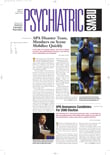Home videotapes have documented what parents of many autistic children have long claimed—that their children were essentially normal during the first year of life, but then deteriorated during the second year into autism.
“This is the first study to use home videotapes to validate autistic regression,” Geraldine Dawson, Ph.D., director of the University of Washington Autism Center, told Psychiatric News.
Dawson, along with Emily Werner, Ph.D., a doctoral student at the university, is the author of the study. Results were published in the August Archives of General Psychiatry.
Most, if not all, information on the phenomenon of autistic regression has been derived either from retrospective parental recall or from a review of medical records. And even though medical records might be less subject to reporting bias than parental recall is, such records may not contain crucial details about a child's early developmental course that would divulge whether he or she was developing autism.
Dawson and Werner obtained home videotapes from the first and second birthdays of 56 subjects. Twenty were typically developing children, and 36 met DSM-IV criteria for autism spectrum disorder. Furthermore, of the 36, 21 had early-onset autism according to their parents, and 15 had regressive-type autism according to theirs. Dawson and Werner then had researchers blind to subjects' diagnostic status scrutinize the videotape footages for particular behaviors—say, babbling, word usage, or looking at people—and then record when, how often, and, in the case of looking at people, how long such behaviors occurred. Dawson and Werner then compared the behavior-assessment results for all three groups of subjects at 1 year and 2 years of age.
At age 1, Dawson and Werner found, the children with regression-type autism behaved more like the typically developing children than they did like the early-onset autism children. For example, they engaged in as much declarative pointing as the typically developing children did, unlike the early-onset children. Declarative pointing is used to share an experience with another person.
In contrast, the children with regression-type autism differed from both the early-onset group and the typically developing group in language use. The regressed children used complex babbling and words significantly more frequently than early-onset children did, with typical children falling in between the early-onset and regressed groups in such use. In fact, the regressed children used complex babble or words nearly twice as often as typical children did.
By age 2, in contrast, the regression group was behaving more like the early-onset group than like the typically developing group or in any idiosyncratic way of its own. For instance, both the regression group and the early-onset group used significantly fewer words than the typical group did. They also responded to their names significantly less often and looked at people significantly less of the time than the typical group did.
Moreover, whereas the typically developing children increased their use of words dramatically between ages 1 and 2, neither the regression group nor the early-onset group made significant gains.
Thus, “this study validates the existence of early autistic regression,” Werner and Dawson concluded in their study report. In fact, the results constitute the strongest scientific evidence yet that autistic regression truly occurs, Dawson contended.
“This study,” she added, “again confirms that autism symptoms are apparent in some children by 1 year of age. It suggests that health professionals should be on the alert for early symptoms such as lack of eye contact, failure to gesture and point, and lack of babbling and words in infants at 1 year of age. These might be early signs of autism.
“The study also confirms that an infant might appear to be developing normally at age 1 but then experience a loss of skills and develop autism in the second or third year of life. Any loss of a previous skill, such as loss of babbling, is a serious red flag. If parents report that their toddler lost skills, the child should be referred for a comprehensive neurodevelopmental evaluation.”
The study was funded by the National Institute of Child Health and Human Development.
Arch Gen Psychiatry 2005 62 889
